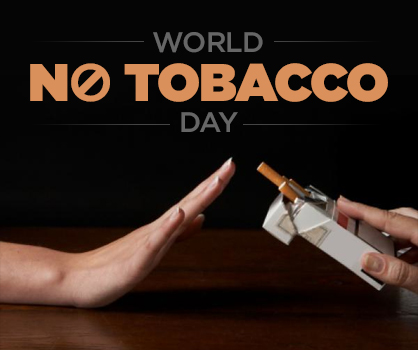World No Tobacco Day: Tobacco Kills 6 Million a Year
Responsible for killing one in 10 adults around the globe, tobacco use represents the single most preventable cause of death internationally. Celebrate WHO’s World No Tobacco Day, held every May 31, by joining in learning the dangers to your health tobacco poses and advocating for effective strategies to decrease the deadly plant’s consumption.
“The ultimate goal of World No Tobacco Day is to contribute to protect present and future generations not only from these devastating health consequences, but also against the social, environmental and economic scourges of tobacco use and exposure to tobacco smoke,” the WHO said.
Tobacco kills up to half of its users, and consumption of tobacco is on the rise internationally. Unless we take action now, the WHO estimates that by 2030, more than 8 million individuals will die each year.
Tobacco is a gradual killer. “The tobacco epidemic is one of the biggest public health threats the world has ever faced … Because there is a lag of several years between when people start using tobacco and when their health suffers, the epidemic of tobacco-related disease and death has just begun,” the WHO stated. Analysis estimates one billion deaths during the 21st century alone.
The vast majority of these deaths will occur in low- and middle-income nations, where the burden is greatest. In some poor countries, children in need work at tobacco farms where they can develop green tobacco sickness from the nicotine that absorbs through their skin as they handle the tobacco leaves.
This year’s theme is banning tobacco advertising, promotion and sponsorship. Under the WHO Framework Convention for Tobacco Control, the organization is calling for a complete prohibition of all tobacco advertising. Such bans have been proven to reduce the number of individuals starting and continuing smoking, making them a cost-effective means of decreasing tobacco demand.
Comprehensive bans help counteract the deceptive industry marketing campaigns, the exposure of youth to tobacco promotion and the lack of self-regulation in the industry. Yet only 6 percent of our planet’s people were protected from exposure to tobacco advertising in 2010.
“(The 2013 campaign aims to) drive local, national and international efforts to counteract tobacco industry efforts to undermine tobacco control, specifically industry efforts to stall or stop comprehensive bans on tobacco advertising, promotion and sponsorship,” the WHO asserted.
As the WHO FCTC garners support, the tobacco industry moves to ramp up its misleading marketing antics, attempting to destroy public health efforts to create bans on advertising, promotion and sponsorship. When banning efforts score results, the tobacco industry has attempted to sue governments in national courts and through international trade venues.
“The tobacco industry and its allies remain rich and powerful, buying influence to undermine tobacco control efforts and spreading myths about tobacco control, such as that it infringes on ‘smokers' rights’ and reduces tobacco's supposed economic benefits,” the WHO stated.
You don’t have to be a smoker to be at risk: Second-hand smoke kills, claiming the lives of 600,000 per year. The WHO maintains there is no safe level of exposure. Of the more than 4,000 chemicals in cigarette smoke, 250 have been found to be harmful and more than 50 cause cancer. Children are also endangered, with more than 40 percent of children having a parent who smokes.
“Every person should be able to breathe smoke-free air,” the WHO declared. “Smoke-free laws protect the health of non-smokers, are popular, do not harm business and encourage smokers to quit.”
Studies have revealed that many do not fully comprehend the dangers of tobacco use. A 2009 survey in China discovered that a mere 38 percent of smokers were aware the habit causes coronary heart disease and only 27 percent knew it causes stroke. Those smokers who are cognizant of the risks by and large want to quit, but many low- and middle-income countries lack the resources to provide support services. Users are not getting the help they need to stop.
“What we need now is more political will to implement the policies,” the WHO said. “More money is essential, too. Generally speaking, tobacco control efforts are seriously underfunded.”
For more information, visit World No Tobacco Day 2013.
Tagged in: philanthropy, who, no tobacco day, cigarettes, tobacco, tobacco use, world health organization, world no tobacco day,

LadyLUX



